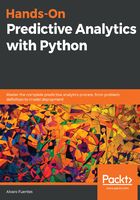
Context is everything
What we call Problem understanding and definition is the first stage in the process, and as we mentioned in the last chapter, this is a key stage because here is where we establish, together with the stakeholders, what the goals of the predictive analytics project are:
- What is the problem that needs to be solved?
- How does the solution look from a business perspective?
So, your first task in any predictive analytics project is to understand the business or subject the problem comes from. As we mentioned back in Chapter 1, The Predictive Analytics Process, you will always be doing predictive analytics within a specific domain and it is obvious that the more you understand that domain, the better you will be able to understand its problems and propose good solutions.
In fact, domain knowledge is maybe the one thing that will make you very valuable and that will give you a great advantage over other analytics professionals; other people may have better software skills, write code in 12 programming languages, or be able to write a proof of Lévy's continuity theorem (by the way, none of those things will be important to the business people you will interact with in 99% of predictive analytics projects); however, if you understand the vocabulary used in the industry, the problems the organization is dealing with, and how the potential solution will bring value to the business, then you will be much more valuable than other professionals, with massive bonus points if you can state the impact of your solution in measurable terms such as money, hours saved, costumers retained, and so on.
Even if you are not an expert in the industry you are working for (as has been the case for me many times), you need to have enough context about the problem: context is everything to be able to understand the problem and propose a solution that delivers value. The task of translating a business need into an analytical problem is a key part of the predictive analytics process; most of the time it won’t be so easy because you will encounter vague and general statements such as, "We need to give tools to the customer service representatives to avoid the churn of our clients," "We want to know what the effects of competition on our business are," or, "Why is the default rate going up in our credit card segment?" So, to understand how to use predictive analytics to deliver satisfactory answers to those questions, you need to know something about the interactions of the customer service representatives with the customers, the dynamics of competition in the industry, and how the "default rate" is defined.